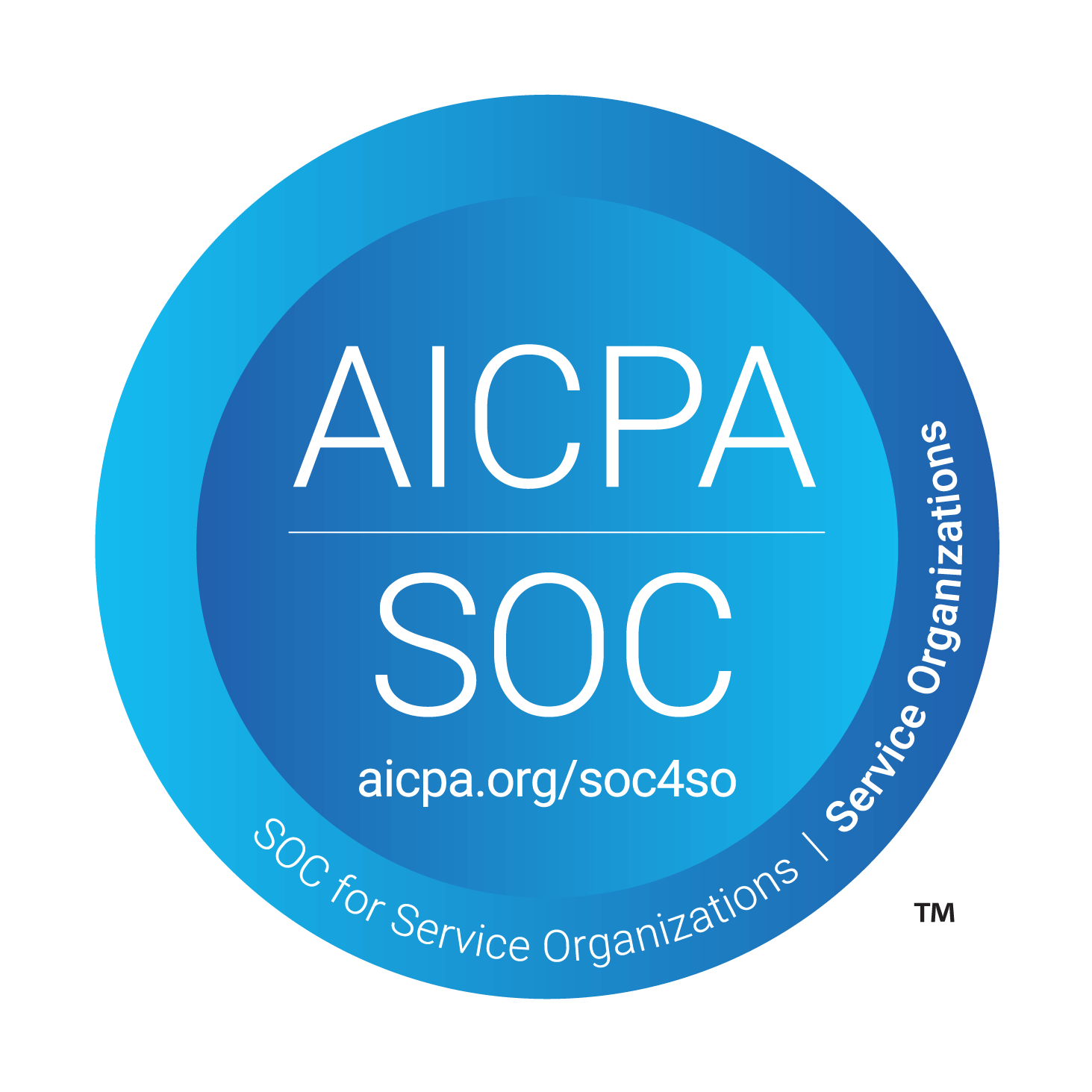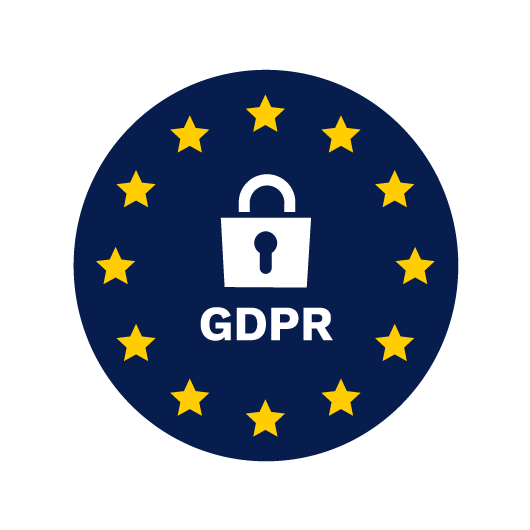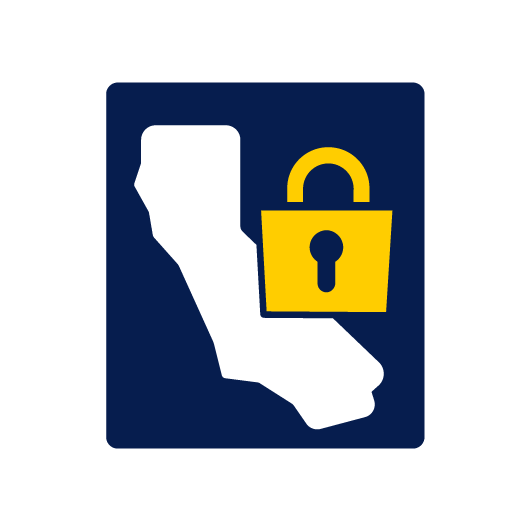How to Prepare for an EHS Audit and Prevent Common Mistakes
EHS audits serve as your organization's early warning system — they help you identify and address compliance gaps before they escalate into serious problems.
While these audits are crucial for protecting your workers, environment, and bottom line, many organizations struggle with conducting them effectively due to resource constraints, complex regulations, and stakeholder resistance.
This guide will show you how to transform your EHS audits from a compliance burden into a powerful tool for improvement. You'll learn practical strategies for preparing thoroughly and avoiding common pitfalls.
Let’s make your next EHS audit more effective and less stressful.
What are EHS audits?
An EHS audit evaluates your organization's Environmental, Health, and Safety practices. Through this systematic review, you'll examine workplace safety protocols, environmental controls, and health risk management systems to ensure they meet regulatory requirements and protect your workers and environment effectively.
The purpose extends beyond basic compliance – you're working to prevent incidents before they occur and identify opportunities for improvement.
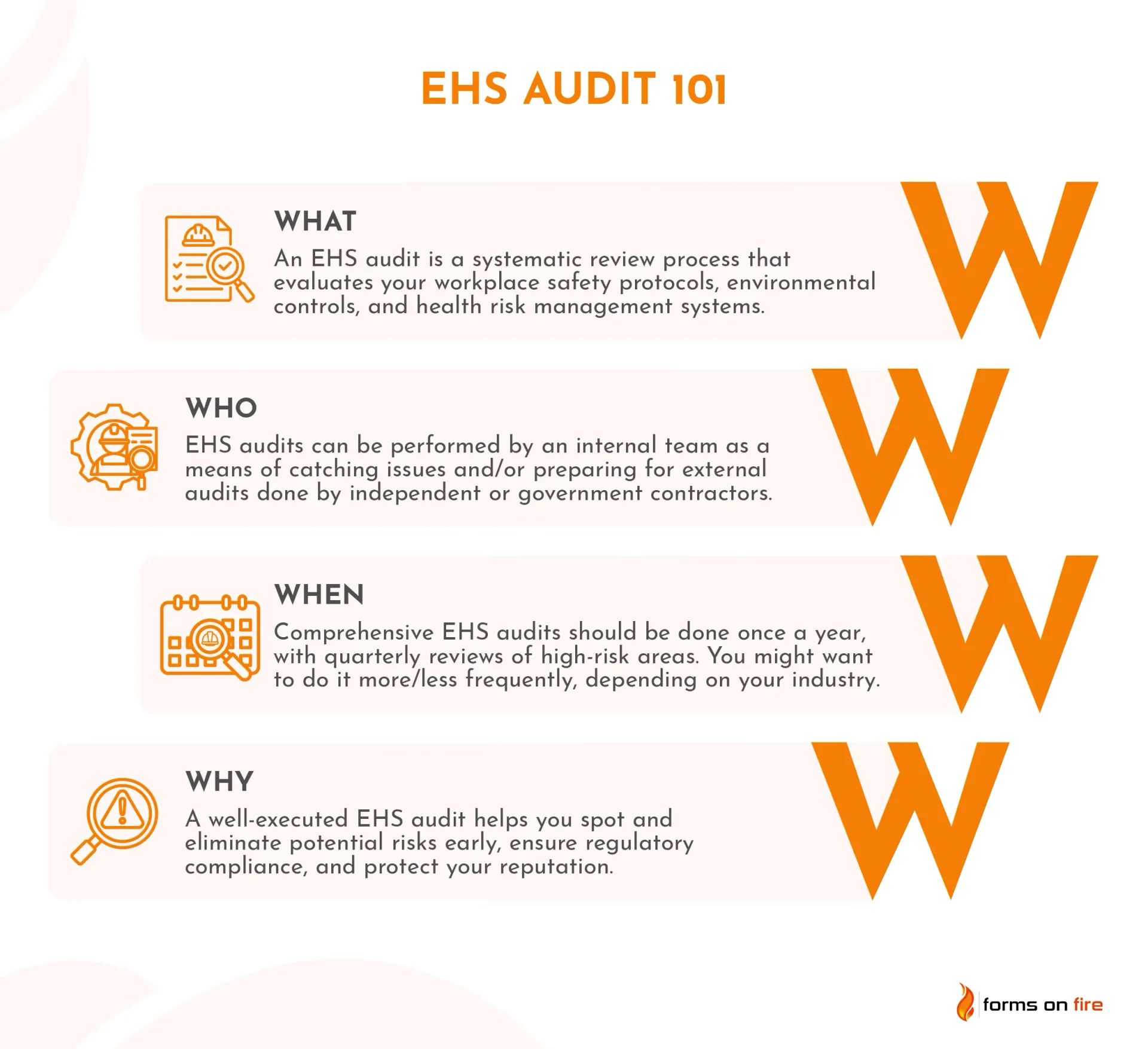
In other words, a well-executed EHS audit helps you:
- Spot potential risks early
- Ensure regulatory compliance
- Uncover ways to enhance operational efficiency through better resource management.
Voluntary vs mandatory EHS compliance audits
Broadly speaking, there are two types of EHS audits: voluntary and mandatory.
Voluntary audits, often led by your internal EHS team, serve as your proactive tool for maintaining compliance and catching safety issues. They can also help you prepare for official regulatory inspections.
Mandatory audits become necessary in specific situations that require external verification:
- After violations: When your organization faces regulatory violations, agencies typically require third-party audits to verify you've corrected the issues and implemented proper controls to prevent future occurrences.
- During settlement agreements: Regulatory agencies often include mandatory audit requirements to verify you're meeting the agreement's terms and maintaining compliance.
- Due to industry regulations: For example, if you operate under certain EPA permits or handle hazardous materials, regular third-party audits may be required to maintain your operating license.
How often should you conduct an EHS audit? For best results, we recommend implementing a risk-based audit schedule. For instance, you can conduct comprehensive internal audits annually, with quarterly reviews of high-risk areas.
You’ll want to adjust this frequency based on your industry requirements and operational complexity. Remember: consistent, focused reviews yield better results than sporadic, overwhelming assessments.
Here’s how to prepare for an EHS audit
Let's explore the essential steps you need to take before your EHS audit begins — from defining its scope to preparing your team and documentation.
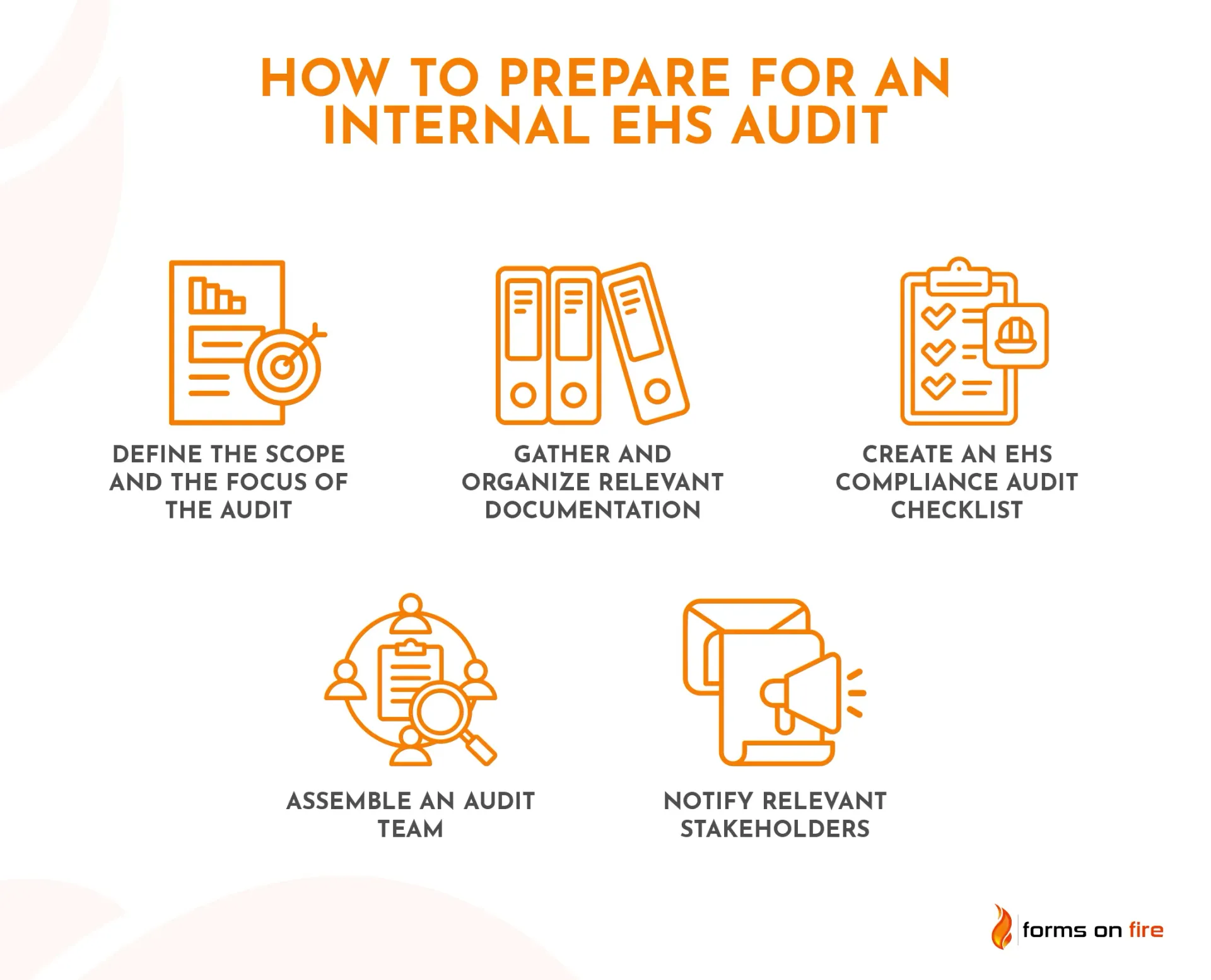
Define the scope and the focus of the audit
Start by determining which aspects of your EHS program need examination based on your current priorities and risk areas.
Your audit might cover several key compliance areas, including:
- Air quality and emissions monitoring
- Hazardous materials handling and storage
- Occupational safety programs
- Waste management practices
- Emergency response protocols
- Employee health monitoring.
Next, identify all regulations, standards, and policies for your selected scope. This includes federal regulations like OSHA and EPA requirements, state and local mandates, industry-specific standards, and your internal policies.
This will help you create a comprehensive checklist that captures all these requirements — it will serve as your roadmap during the audit.
Set clear, measurable objectives for your audit that go beyond basic compliance checking and align with your broader EHS goals. Whether you're aiming to identify gaps, evaluate recent program changes, or assess risk exposure, having specific goals helps you design an audit approach that delivers meaningful insights.
Gather and organize relevant documentation
Gathering the right documentation before your audit helps you paint a complete picture of your EHS compliance status — you'll want to ensure every required document is available, up-to-date, and properly organized.
The documentation you'll need to gather can include:
- Environmental permits and associated reports
- Safety inspection records and incident reports
- Employee training documentation
- Previous audit findings and corrective actions
- Standard Operating Procedures (SOPs) related to EHS practices
- Monitoring and testing records
- Submitted incident report forms
- Emergency response plans
- Chemical inventory lists
- Equipment maintenance logs.
Having modern EHS software like Forms On Fire makes this waaay easier. Instead of digging through file cabinets and spreadsheets, you can centralize documentation, track expiration dates, and quickly access records during your audit.
Create an EHS compliance audit checklist (if preparing for an internal audit)
When preparing for your internal EHS audit, review previous audit reports to spot patterns of recurring issues — to see if your corrective actions worked or if the systemic problems persist. This historical perspective helps you focus your upcoming audit on areas that have consistently challenged your organization.
Next, you should create EHS audit checklists. The can include:
- Regulatory requirements that apply to your operations
- Internal policies and procedures that govern your EHS practices
- Previous findings that need follow-up verification
- Industry best practices relevant to your operations
- Site-specific requirements and local regulations.
Forms On Fire simplifies this process by helping you create digital checklists that will systematically guide your EHS management team through each audit point. Because they can use their forms on their phones or tablets, the auditors will be able to make comments, take pictures, and even record videos.
Below is a snapshot of an EHS checklist. You can use Forms On Fire to quickly transform such a paper template into a digital form.
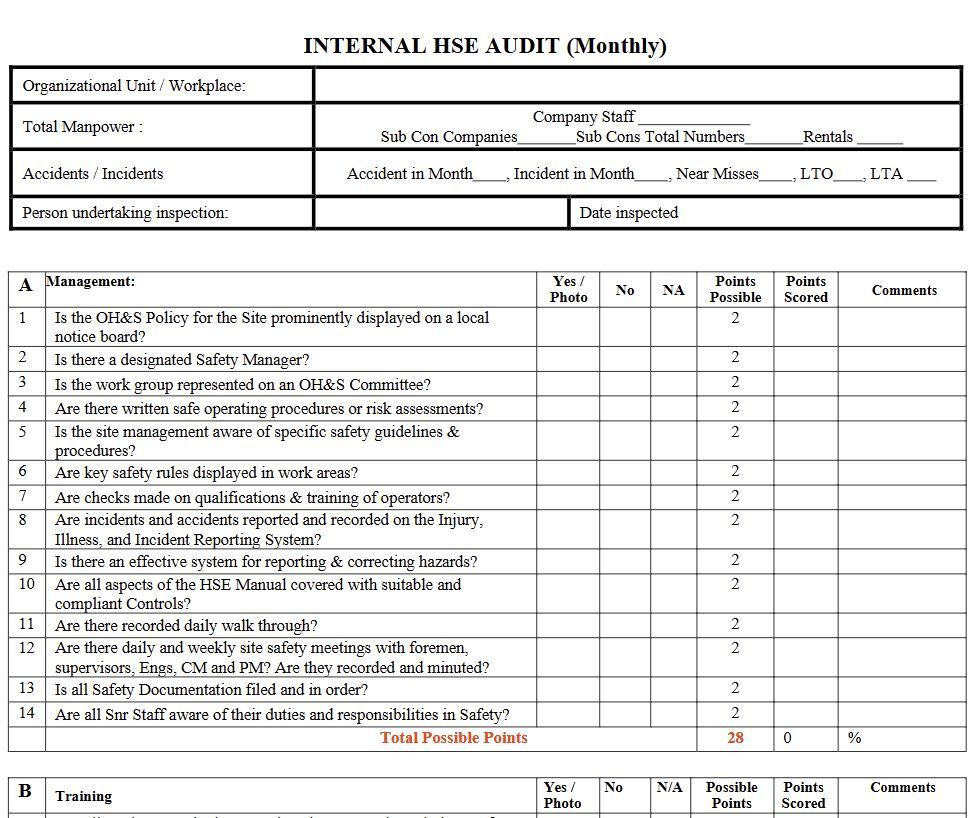
By digitizing the process, you'll capture findings more efficiently, maintain better documentation, and track improvements more effectively than using pen and paper.
Assemble an audit team (if preparing for an internal audit)
When assembling your audit team, you'll need the right mix of expertise to ensure a thorough and effective assessment.
Select team members who understand both EHS regulations and your specific operations. By combining technical knowledge with practical experience, they'll spot issues that those with only theoretical knowledge might miss.
Your audit team should include:
- At least one member with strong regulatory knowledge of your industry
- Someone familiar with your day-to-day operations
- A team member experienced in audit methodologies.
If needed, you can bring in external auditors to complement your internal team. They often provide valuable unbiased perspectives and help identify your blind spots. External experts also bring experience from other facilities and industries, helping you benchmark your practices against broader industry standards.
Notify relevant stakeholders
Clear communication with stakeholders is crucial for the success of an EHS audit. Here’s what you should include in your notifications:
- Audit scope and objectives
- Schedule of activities and locations to be audited
- Roles and responsibilities during the audit
- How and when findings will be shared
- What kind of cooperation you'll need from each department.
Enterprise-level organizations should consider assigning point persons in each department who will help coordinate information requests and facilitate access to documentation or areas being audited. They will be your bridges between the audit team and department personnel.
Remember to address any concerns proactively. When people understand that the audit's goal is improvement rather than fault-finding, they're more likely to participate openly and constructively in the process.
The typical EHS audit process
Whether you are inspecting safety, environmental compliance, or IT security, the steps for conducting internal audits will look pretty much the same. You can see them described in the image below.
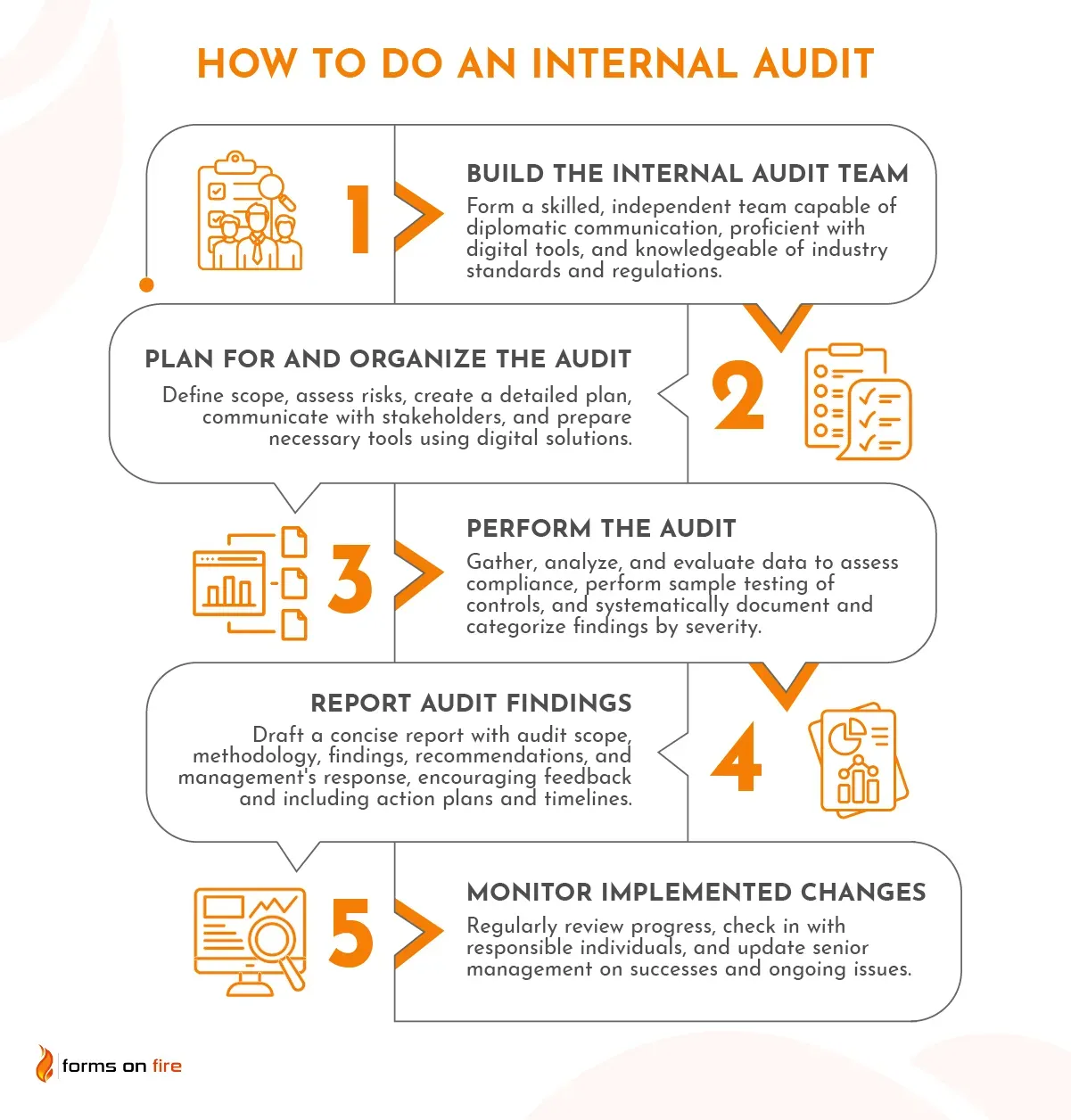
If you want to dive deeper into each step, check out our guide on how to perform internal audits.
Common challenges in EHS auditing (and possible solutions)
As you prepare for your EHS audit, you'll likely encounter several common challenges that could impact its effectiveness. Understanding these challenges and having strategies ready to address them will help you conduct more successful audits that drive real improvements in your EHS program.
Resistance from employees or management
Resistance often stems from fear of negative findings, concerns about operational disruptions, or misconceptions about the audit's purpose. When employees or management view audits as punitive rather than improvement opportunities, they might withhold information, provide minimal cooperation, or create barriers that prevent a thorough assessment.
To overcome this resistance, focus on building a positive audit culture:
- Communicate early and often about the audit's purpose as a tool for improvement, not punishment.
- Share success stories from previous audits where findings led to positive changes.
- Involve key stakeholders in the audit planning process to give them a sense of ownership.
- Recognize and reward departments that demonstrate proactive participation.
- Provide regular updates during the audit process to maintain transparency.
- Frame findings as opportunities for improvement rather than failures.
Incomplete or disorganized documentation
When records are scattered across different locations, stored in various formats, or simply incomplete, you'll waste valuable time searching for information instead of conducting meaningful assessments.
Transform your documentation management with these practical tips:
- Use Forms On Fire or a similar digital tool to centralize all EHS records and automate record-keeping.
- Create standardized filing protocols.
- Establish a regular documentation review schedule to identify gaps before audits.
- Assign clear responsibility for maintaining specific types of documentation.
- For paper documents, develop a master list of required files with their locations and review dates.
- Set up automatic notifications for document updates and renewals.
Lack of resources
Limited resources — whether it's time, personnel, or budget — can significantly impact your ability to conduct thorough EHS audits. This challenge particularly affects small and medium-sized enterprises (SMEs), where limited budgets and personnel might lead to rushed assessments or postponed audits, potentially missing critical compliance issues.
Address resource constraints strategically:
- Prioritize audit areas based on risk levels and compliance history.
- Break down comprehensive audits into smaller, manageable assessments.
- Leverage technology to automate data collection and reporting.
- Cross-train team members to build internal audit capabilities.
- Consider outsourcing specific technical assessments while keeping routine checks in-house
- Create standardized templates, procedures, and checklists to improve efficiency.
- Demonstrate ROI by comparing audit costs against potential fines.
Constant regulatory changes combined with the lack of auditor expertise
Depending on your industry, staying current with regulatory changes can feel like trying to hit a moving target. And if your internal team is inexperienced, you risk missing crucial compliance issues or misinterpreting requirements, especially if you operate across multiple jurisdictions.
Here are some ideas for keeping your audit program strong and current:
- Create a system for tracking and reviewing regulatory updates regularly.
- Invest in ongoing training to keep your internal auditors sharp and up-to-date.
- Join industry associations like ASSP, NAEM, or NSC where you can learn about upcoming changes early.
- Partner with regulatory experts for guidance on complex requirements.
- Bring in third-party auditors for specialized assessments.
- Build a digital knowledge base to share insights across your audit team.
- Use audit management software to incorporate new requirements quickly.
Ineffective communication of findings
When findings aren't clearly communicated or effectively shared with the right stakeholders, you risk missing improvement opportunities — and repeating the same issues in future audits. Plus, without clear communication of priorities and action items, your recommendations might sit unused rather than drive improvements.
Strengthen your audit communication with these practical steps:
- Present findings in clear, actionable language that avoids technical jargon.
- Prioritize findings based on risk level and urgency.
- Create executive summaries for leadership alongside detailed reports.
- Use visual aids like charts and photos to illustrate key points and stats.
- Set up a clear system for tracking corrective actions.
- Schedule follow-up meetings to review progress on recommendations.
- Use digital tools to maintain an easily accessible record of findings and actions.
Build up your EHS audit program with Forms On Fire
Forms On Fire transforms your EHS audit process from a complex, paper-based burden into a streamlined digital system that drives positive change. Think of it as your command center for managing health, safety, and environmental compliance.
The Forms On Fire platform helps you:
- Create custom EHS audit checklists (we have a database with dozens of safety-related templates you can pick and adjust)
- Capture photos, video, and timestamps during inspections
- Generate instant reports to spot trends and prioritize actions
- Enable multiple team members to collect data simultaneously (and with our offline capabilities, they can do that even in areas with poor internet access)
- Sync all information in real-time across locations
- Maintain a clear audit trail for every finding
- Track corrective actions and their implementation
- Access all your audit data from one centralized platform.
Ready to digitize your EHS audit process? Schedule a personalized demo with our team and discover how Forms On Fire can help you conduct more efficient, thorough, and effective audits.

